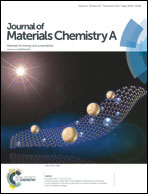PANI–PEG copolymer modified LiFePO4 as a cathode material for high-performance lithium ion batteries†
Abstract
The poor electronic conductivity and low lithium ion diffusion rate of a LiFePO4 cathode material are the two major obstacles for its commercial applications in the power lithium ion batteries. This article utilized an electroactive and ion conductive copolymer, polyaniline–poly(ethylene glycol) (PANI–PEG), to modify carbon-LiFePO4 (cLFP) by a facile in situ chemical copolymerization method. The structure and morphology of the cLFP/PANI–PEG composite were confirmed by Fourier transform infrared spectroscopy (FTIR), X-ray diffractometry (XRD), scanning electron microscopy (SEM) and transmission electron microscopy (TEM). Compared with a cLFP/PANI composite, the cLFP/PANI–PEG composite exhibited a more uniform and full polymer coating layer. Furthermore, this cLFP/PANI–PEG cathode material exhibits excellent cyclic stability (95.7% capacity retention after 100 cycles at 0.1 C) and high rate capability (125.3 mA h g−1 at 5 C) as the PANI–PEG copolymer coating layer facilitated electron and ion transport within the electrode. Electrochemical impedance spectroscopy (EIS) proved that the lithium ion diffusion in the cLFP/PANI–PEG composite was increased significantly by one order of magnitude compared with cLFP, indicating its possibility to be served as a cathode material for high-performance lithium ion batteries.


 Please wait while we load your content...
Please wait while we load your content...